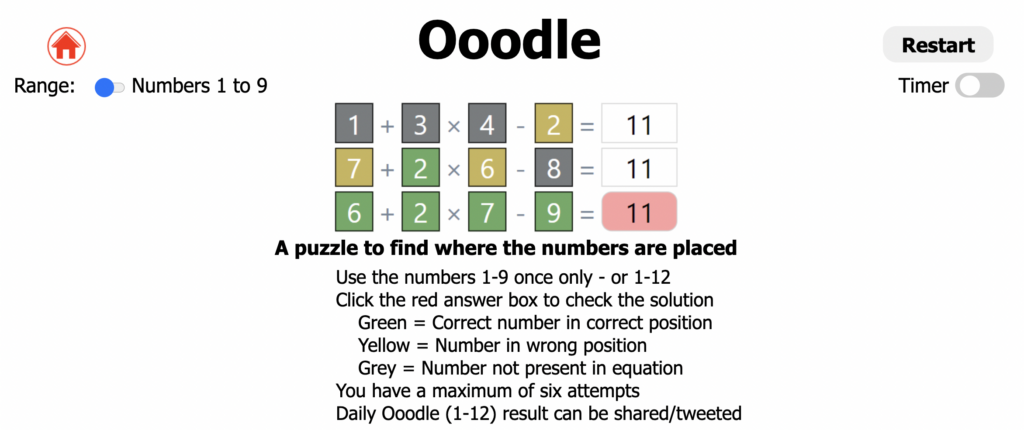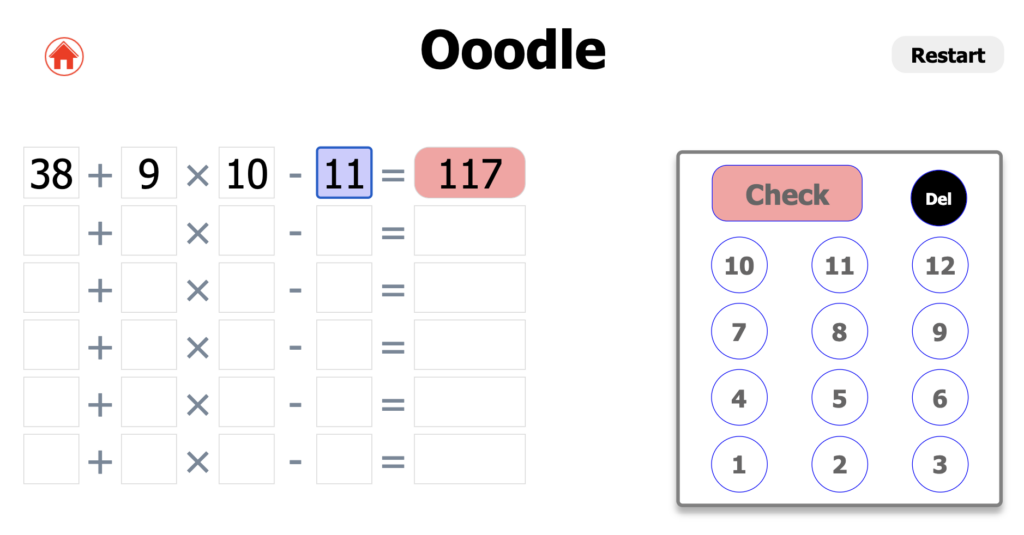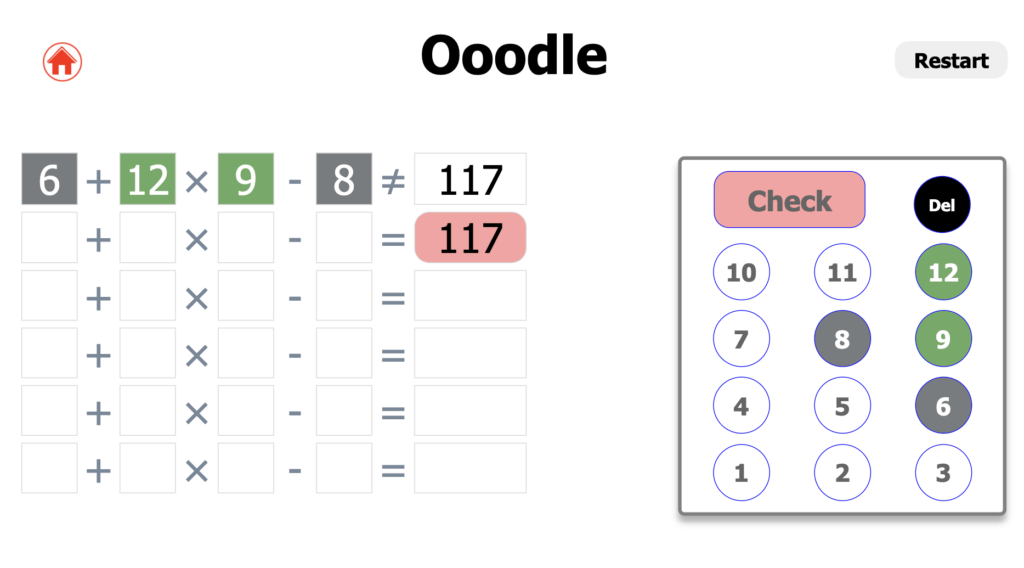Chances are you have heard of the wildly popular 5-letter daily word game known as Wordle. It was a huge topic of conversation (and perhaps even frustration) all over the world during much of last year. Capitalizing on its popularity among people of all ages, educators have also come up with smart ideas for teaching with Wordle and its spinoff educational games. One of those new games to follow behind Wordle actually does have a similar name. It is known as the Oodle math game and involves a very similar premise to the Wordle games. So, in our newest Rising Resources post, we'll explore how to use it in the classroom.
The Wordle for teaching math.
If you're familiar with playing Wordle, Oodle is extremely similar. Instead of guessing a 5-letter word without any context, however, kids must build out math equations that help them to arrive at the on-screen answer. For example, if the answer to a daily Oodle puzzle was 41, kids would have to fill in the other four pieces of that equation that would lead to 41 as the answer. They have six tries to correctly guess the equation—just like in Wordle—and they can only use the numbers 1-9 (or 1-12) once on each line. Like Wordle, Oodle also shows correct numbers (yellow) and correct numbers in correct spots (green).

Like Wordle, children can only use Oodle through a browser. It is easy to access, however, and they could quickly find it using a simple Google search or access the Oodle environment here. Once they are on the Oodle homepage using either their computer or mobile device, children can first choose whether they want to use the numbers 1-9 or the numbers 1-12. Of course, for younger kids, using nine digits is easier but, for older students, using 1-12 presents a greater challenge. Since they can also see the answer to an equation when beginning a new puzzle, that serves as their starting point. They'll then have to build out an equation that gets them to that answer.
Getting started with Oodle puzzles.
Students could also choose to enable the Oodle timer on the home page. This creates a timed experience and adds a bit of pressure to solving each Oodle puzzle. If they didn't enable the timer, they'd theoretically have the whole day to solve a puzzle—just like Wordle. There are also practice Oodles available if students want to get more comfortable before attempting to solve the daily puzzle. They can use these once they've solved or failed to solve the daily puzzle, too. To start, all they have to do is click the green button that says Daily Oodle. From there, they'll enter the environment and they can begin trying to solve the puzzle.

When working, kids also need to keep in mind a golden rule for mathematics education—known fondly as PEMDAS. That's because remembering the order of operations is always important when learning with the Oodle math puzzles. There could be a mix of addition, subtraction, multiplication, and maybe even division signs in any of the given puzzles. So, as we know (or perhaps we need a refresher), PEMDAS spells out the correct order of operations when there are multiple elements in math equations. To help children remember this, you can refer to the PEMDAS acronym by reciting Please Excuse My Dear Aunt Sally. It also (actually) stands for parentheses, exponents, multiplication, division, addition, subtraction—spelling out the order in which students should address the elements of an equation.
Strategies for solving math puzzles.
So, for the equation in the image above, students need to provide four numbers—one for each of the blank slots. Then, the first thing they'll do is multiplication since that's the first letter of PEMDAS that's involved in this equation. Maybe they will start with nine and 10 (since they can't use the same numbers twice) and put those into the two slots on either side of the multiplication sign. Students can simply type the numbers into the boxes and they will appear. Then, knowing that 9 X 10 equals 90 and the answer to the equation is 117, they'll have to test what other numbers might work for the other slots.
They could try putting 38 in that first box, for example. This would give them 38 + 90 (remember PEMDAS), which equals 128. Then, for their final box, they would put in 11 to get the equation to equal 117. Now that the equation is logical, children could click the Check button to see if it's the right one. If they did try using these numbers, however, they'd see a message reminding them they must use only the numbers between one and 12, so this (while technically correct) is not the solution to this Oodle puzzle. We can also deduce, however, that the two numbers being multiplied need to produce a number that is higher than 117 when it is added to the eventual first number of the equation since the final piece of the equation is subtraction.
Using the Oodle interface in lessons.
Knowing that, we could try 12 X 10, which equals 120. Students could then try six, for example, as the first number in the equation. This would give them 126 and would leave nine as the number to place in the final slot. Now, they would check their equation and see if it's correct. Unfortunately, this didn't work right either because it says you can only use each digit just one time. We assumed this means that you can't use both 12 and 10 because they each have the digit '1' in them, which is confusing (more on this later). So, maybe they will try 12 X 9 next, which we did and, after hitting the Check button, we can see that was correct but the other two pieces were not. Also, as the negated equals sign indicates, this equation isn't even correct.

So, we know which two numbers are being multiplied and we must figure out the remaining pieces. On the right side, you'll also see which numbers we've already used. The 12 and 9 are green to signify they're part of the equation and in their correct place. The 8 and 6 are gray to remind kids that they guessed incorrectly with those two. So, they'll start with the 12 and 9 in the same spots and build out the rest of their equation. Since 12 X 9 equals 108, they can try 11 + 12 X 9 - 2 but that is wrong. It seems the correct answer should be 10 + 12 X 9 - 1 = 117, but the system was not accepting that. Eventually, on my last guess, it accepted 10 as the first number in the equation but would not accept 1. It also did not show the correct answer.
Getting started with Oodle or other STEM tools.
It seems there was a technical issue when we tried Oodle but it's still a relevant learning game. Solving this equation was challenging, and definitely more for upper elementary or middle school students. High school students could definitely try it out, too. If you'd like to give it a try, you can start by projecting today's Oodle puzzle for students to see. Or, if kids all have their own devices, they can each try solving it individually and see who gets the correct combination first. To try it, head over to the Oodle platform on your browser—you can access new puzzles every day. After that, check out some of the STEM and coding tools on our store for additional math class connections. Follow us on Twitter and Instagram for more.



